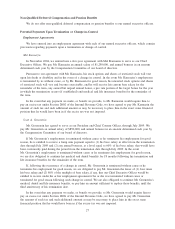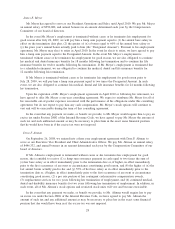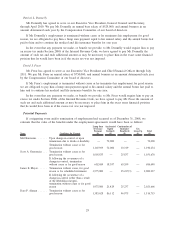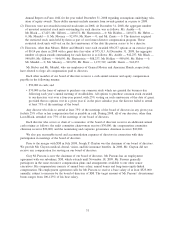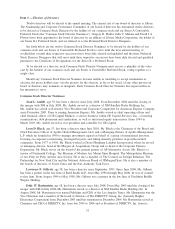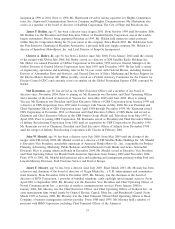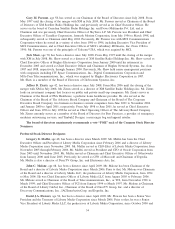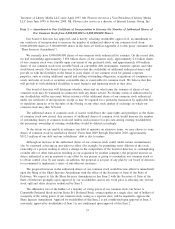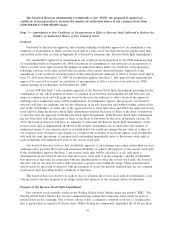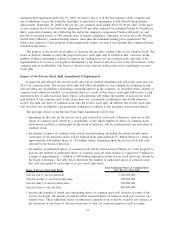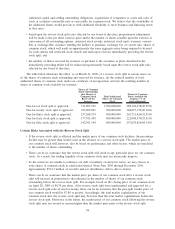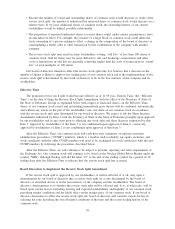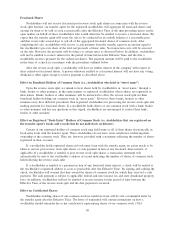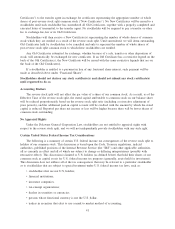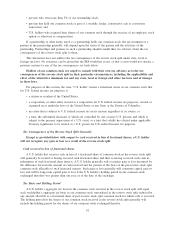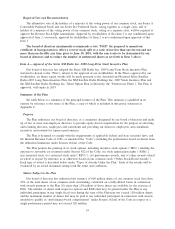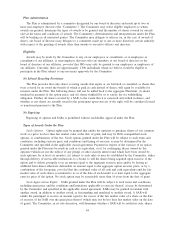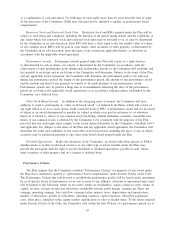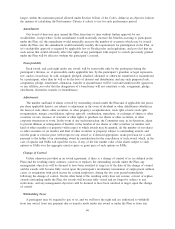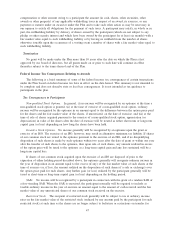XM Radio 2008 Annual Report Download - page 149
Download and view the complete annual report
Please find page 149 of the 2008 XM Radio annual report below. You can navigate through the pages in the report by either clicking on the pages listed below, or by using the keyword search tool below to find specific information within the annual report.
minimum bid requirement until July 19, 2009, we believe that it is in the best interests of the company and
our stockholders to give the board the flexibility to meet these requirements if and when Nasdaq resumes
enforcement. September 19, 2008 is the last day our common stock traded above $1.00 per share. If the price
of our common stock closes below the minimum $1.00 per share required for continued listing by Nasdaq for
thirty consecutive business days following the end of the temporary suspension, Nasdaq will notify us and
provide us an initial period of 180 calendar days to regain compliance. Currently, we meet all of the Nasdaq
Global Select Market’s continued listing criteria, other than the minimum trading price requirement. We
believe that approval of this proposal would significantly reduce our risk of not meeting this continued listing
standard in the future.
The purpose of the reverse stock split is to increase the per share trading value of our common stock. Our
board of directors intends to effect the proposed reverse stock split only if it believes that a decrease in the
number of shares outstanding is likely to improve the trading price for our common stock, and only if the
implementation of a reverse stock split is determined by the board of directors to be in the best interests of the
company and its stockholders. Our board of directors may exercise its discretion not to implement a reverse
stock split.
Impact of the Reverse Stock Split Amendment if Implemented
If approved and effected, the reverse stock split will be realized simultaneously and in the same ratio for
all of our common stock. The reverse stock split will affect all holders of our common stock uniformly and
will not affect any stockholder’s percentage ownership interest in the company. As described below, holders of
common stock otherwise entitled to a fractional share as a result of the reverse stock split will receive a cash
payment in lieu of such fractional share. These cash payments will reduce the number of post-reverse stock
split holders of our common stock to the extent there are concurrently stockholders who would otherwise
receive less than one share of common stock after the reverse stock split. In addition, the reverse stock split
will not affect any stockholder’s proportionate voting power (subject to the treatment of fractional shares).
The principal effects of the Reverse Stock Split Amendment will be that:
• depending on the ratio for the reverse stock split selected by our board of directors, each ten or fifty
shares of common stock owned by a stockholder, or any whole number of shares of common stock
between ten and fifty as determined by the board of directors, will be combined into one new share of
common stock;
• the number of shares of common stock issued and outstanding (including the shares issuable upon
conversion of our preferred stock) will be reduced from approximately 6.5 billion shares to a range of
approximately 646 million shares to 129 million shares, depending upon the reverse stock split ratio
selected by the board of directors;
• the number of authorized shares of common stock will be reduced from 8 billion (or, if the proposal to
increase the number of authorized shares of common stock set forth in Item 2 is approved, 9 billion) to
a range of approximately 1.3 billion to 400 million dependent on the reverse stock split ratio chosen by
the board of directors. The table below illustrates the number of authorized shares of common stock
that will correspond to each range of reverse stock split ratios:
Range of Reverse Stock Split Ratios
Total Authorized Shares of Common Stock
after Reverse Stock Split
One-for-ten to one-for-nineteen ....................... 1,300,000,000
One-for-twenty to one-for-twenty-nine .................. 700,000,000
One-for-thirty to one-for-thirty-nine .................... 500,000,000
One-for-forty to one-for-fifty ......................... 400,000,000
• because the number of issued and outstanding shares of common stock will decrease as result of the
reverse stock split, the number of authorized but unissued shares of common stock may increase on a
relative basis. These additional shares of authorized common stock would be available for issuance at
the discretion of our board of directors from time to time for corporate purposes such as raising
37


